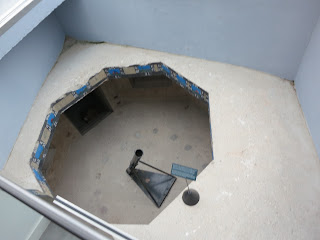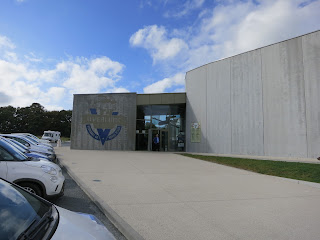I have dared to stand where giants tread, where the blood
of a generation spilled out upon the wind whipped sands. I have dared to see the place where young men
fought against an unspeakable evil, threw their lives against what was
considered an impenetrable wall built against them. I do not dare to presume I was worthy to
stand in such places, to see such things, to bear witness to a place where such
history happened. These words, these thoughts
are what can best summarize the beaches of Normandy and the ruins of the
Atlantic wall. Few other places or
things have moved me so much on so many levels – spiritual, physical,
emotional.
The morning dawned with cloud covered skies, and a heavy
rain had covered the town of Bayeux. We
set out by car for Utah Beach to begin our pilgrimage, and to all who come to
this place, I suggest the exact same route – you will see why. Utah is the Southern most of the landing
points, but it houses the best museum of all the ones out there. When we arrived we stepped out of the car
into driving winds and a pattering of rain.
It whipped against us, over the dunes and the sea grass as we climbed
one of the sandy peaks. There,
stretching out before us was the Atlantic ocean, with waves crashing one
against another upon the beach itself.
It is a surreal experience to stand there, to see this
place as it is now. There is the museum
of course, a memorial, and one can even walk out on the beach itself. This latter part confused me, as it is a
place were men fought and died. I
suppose though, it is a part of history and they wish to give access to all who
want it – we chose not to go out. There
are a few things other than the memorial that is out there, a few anti-tank
objects, a mortar or two, a tank itself, etc.
It was a grim, solemn place that seemed clouded by the memories of war.
Yet it was a good place as well. The "Debarquement Musee" is a fantastic museum set
in the ruins of an old bunker. Wandering
around you can see where mortar placements were done and there are excellent
exhibits on the machines, the men and the plans that were involved in the
entire campaign. The museum here set a
tone of perspective for everything else we were to see. One of the highlights was a fully restored
B27 that sits in a hanger in the center of the building.
Utah was one of the most important beaches in Operation
Overlord, though Omaha is the one that is more famous. It was here troops landed in the wrong spot
after the heavy bombing of the surrounding area.
 |
| Exmples of landing craft, machine guns, anti-tank obstacles among other things |
 |
| US Army deployment truck |
 |
| This is one of the Landing craft for D-day. Notice the flat bottom. The craft was meant to land in shallow water and then turn around to go pick up more troops for deployment. |
 |
| Example US Army D-Day fatigues and supplies. They were carrying a TON. |
 |
| The museum is built on an old bunker. This is one of the pits looking down to a mortar gun. |
 |
| Looking out on the Utah Beach Bluffs |
The men here had to push to clear so much land, so that
they could get a firm beachhead. The
Nazi’s had flooded the surrounding countryside. To get a foothold in Europe took the combined thrust of
the 101st airborne from behind and the amphibious landing on all the other beachheads . Stepping back
outside after our visit, it was not hard to mount that same dune again and
stare out over the sea – then picture ships on the horizon. I could imagine them now, the sound of
bullets whizzing past, the distant boom of cannons and the shouts of men. My grandmother, sweet woman she was, would
have taken a tiny pinch of sand as a remembrance. I couldn’t bring myself to do it.
We had a lot more to see. Normandy is huge, and with so much history to be continued in Part 2!
We had a lot more to see. Normandy is huge, and with so much history to be continued in Part 2!































